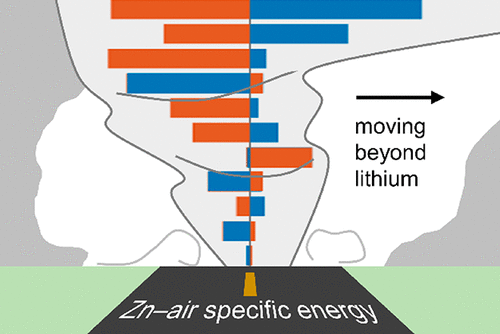当前位置:
X-MOL 学术
›
ACS Energy Lett.
›
论文详情
Our official English website, www.x-mol.net, welcomes your feedback! (Note: you will need to create a separate account there.)
Projecting the Specific Energy of Rechargeable Zinc–Air Batteries
ACS Energy Letters ( IF 22.0 ) Pub Date : 2020-10-13 , DOI: 10.1021/acsenergylett.0c01994 Brandon J. Hopkins 1 , Christopher N. Chervin 2 , Jeffrey W. Long 2 , Debra R. Rolison 2 , Joseph F. Parker 2
ACS Energy Letters ( IF 22.0 ) Pub Date : 2020-10-13 , DOI: 10.1021/acsenergylett.0c01994 Brandon J. Hopkins 1 , Christopher N. Chervin 2 , Jeffrey W. Long 2 , Debra R. Rolison 2 , Joseph F. Parker 2
Affiliation

|
Commercial primary zinc–air batteries provide 450 Wh kgcell–1 (at the cell level), but the practical specific energy of secondary zinc–air batteries remains unclear. Using a specific-energy model and data from reported zinc–air cells, we show that some rechargeable zinc–air electrode materials may already be capable of enabling system-level specific energies between 200 and 450 Wh kgsys–1. These values rival best-case projections for battery packs using lithium–sulfur, lithium metal paired with layered metal oxides, or open lithium–air. By performing a sensitivity analysis on the reported specific-energy model, we show that depth of discharge, areal discharge capacity, and solid-volume fraction of the porous Zn electrode are the most important parameters for increasing specific energy, rather than discharge voltage. To achieve a high specific energy, bipolar zinc–air cells need to cycle above 40% depth of discharge with areal discharge energies >100 mWh cmgeo–2.
中文翻译:

预测可充电锌空气电池的比能量
商业一次锌-空气电池可提供450 Wh kg电池–1(在电池水平),但二次锌-空气电池的实际比能仍不清楚。使用比能模型和报告的锌空气电池的数据,我们表明某些可再充电的锌空气电极材料可能已经能够实现200至450 Wh kg sys –1之间的系统级比能。。这些值与使用锂硫,锂金属与层状金属氧化物配对或开放的锂空气电池组的最佳情况预测相抗衡。通过对所报告的比能模型进行敏感性分析,我们发现,多孔锌电极的放电深度,面积放电容量和固体体积分数是增加比能而不是放电电压的最重要参数。为了获得高的比能量,双极锌-空气电池需要在大于40%的放电深度下循环,其面放电能量> 100 mWh cm geo –2。
更新日期:2020-11-13
中文翻译:

预测可充电锌空气电池的比能量
商业一次锌-空气电池可提供450 Wh kg电池–1(在电池水平),但二次锌-空气电池的实际比能仍不清楚。使用比能模型和报告的锌空气电池的数据,我们表明某些可再充电的锌空气电极材料可能已经能够实现200至450 Wh kg sys –1之间的系统级比能。。这些值与使用锂硫,锂金属与层状金属氧化物配对或开放的锂空气电池组的最佳情况预测相抗衡。通过对所报告的比能模型进行敏感性分析,我们发现,多孔锌电极的放电深度,面积放电容量和固体体积分数是增加比能而不是放电电压的最重要参数。为了获得高的比能量,双极锌-空气电池需要在大于40%的放电深度下循环,其面放电能量> 100 mWh cm geo –2。



























 京公网安备 11010802027423号
京公网安备 11010802027423号